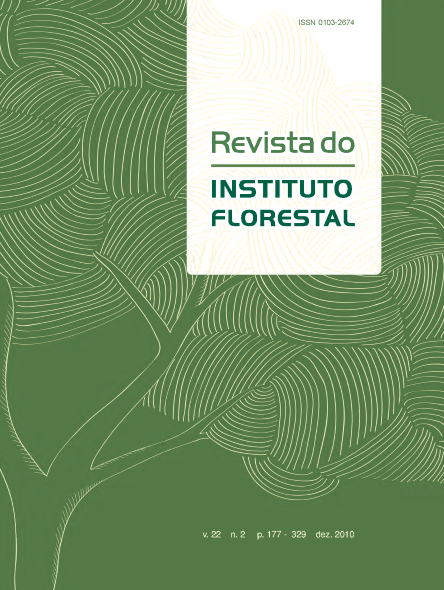GENETIC PARAMETERS AND GAINS WITH THE SELECTION IN OPEN POLLINATED PROGENY TEST OF Eucalyptus pellita, IN BATATAIS−SP
DOI:
https://doi.org/10.24278/2178-5031.2010222264Keywords:
genetic conservation, genetic variability, tree breedingAbstract
The study was established to estimate genetic parameters and expected gains through selection, as well as to evaluate the silvicultural potential of Eucalyptus pellita, at 23 years of age in Batatais, São Paulo State, Brazil. Twenty five open-pollinated families sampled from the natural forest in Australia were tested. The trial was established in 1986 in a randomized block design with single plant plots replicated 100 times. In 2009, height, diameter at breast height, stem form and survival were assessed and the volume was estimated. The 69% survival rate was considered to be satisfactory, since it had never been thinned. The annual growth rate was high in DBH (1.14 cm), height (0.89 m), and volume (0.0316 m³/tree), indicating its high silvicultural potential on the site. The genetic variation and heritability in height at family level ( h2m ) were high (minimum of 5.7% and 0.85, respectively). This indicated the high potential of the material for further improvement through family selection. The estimates of genetic gains through sequential selection among and within families ranged from 29.1% to 85.4% in all traits. These are expected in stands of this material at 23 years of age on a similar site
Downloads
References
ARACRUZ CELULOSE. Centro de Pesquisa e Tecnologia. O que é o eucalipto? In: ARACRUZ CELULOSE. Centro de Pesquisa e Tecnologia. O eucalipto e meio ambiente em tempos de aquecimento global. Disponível em: . Acesso em: 19 set. 2009.
FREITAS, M.L.M. et al. Parâmetros genéticos em progênies de polinização aberta de Pinus caribaea var. bahamensis, aos 22 anos de idade. Rev. Inst. Flor., v. 17, n. 1, p. 103-111, 2005.
FREITAS, M.L.M. et al. Variação genética em progênies de Myracrodruon urundeuva F.F. & M.F. Allemão em três sistemas de cultivo. R. Árvore, v. 30, n. 3, p. 319-329, 2006.
FREITAS, M.L.M. et al. Pomar de sementes por mudas a partir da seleção dentro em teste de progênies de Myracrodruon urundeuva Fr. All. Rev. Inst. Flor., v. 19, n. 2, p. 65-72, 2007.
FOELKEL, C. Eucalyptus online book e newsletter – pergunta 68. 2009. Disponível em: . Acesso em: 25 set. 2009.
HALLAUER, A.R.; MIRANDA FILHO, J.B. Quantitative genetics in maize breeding. Ames: Iowa State University Press, 1988. 468 p.
HOUSE, A.P.N.; BELL, J.C. Genetic diversity, mating systems and systematic relationship in two red mahoganies, Eucalyptus pellita and E. scias. Aust. J. Bot., v. 44, p. 157-174, 1996. INSTITUTO DE PESQUISAS FLORESTAIS – IPEF. Chave de identificação de espécies florestais, Eucalyptus pellita. Piracicaba, 2004. Disponível em: . Acesso em: 19 set. 2009.
LEKSONO, B.; KURINOBU, S.; IDE, Y. Realized genetic gains observed in second generation seedling seed orchards of Eucalyptus pellita in Indonesia. Journal of Forest Research., v. 13, n. 2, p. 110-116, 2008.
MAGALHÃES, W.M. et al. Desempenho silvicultural de espécies de Eucalyptus spp. em quatro espaçamentos de plantio na região noroeste de Minas Gerais. Floresta e Ambiente, v. 12, n. 2, p. 1-07, 2006.
MORAES, M.A. et al. Variação genética para caracteres silviculturais em progênies de polinização aberta de Eucalyptus camaldulensis em Luiz Antônio−SP. Rev. Inst. Flor., v. 19, n. 2, p. 113-118, 2007.
NAMKOONG, G. Introduction to quantitative genetics in forestry. Washington, D.C.: Forest Service, 1979. 342 p. (Technical Bulletin, 1588).
NOVA, N.A.V.; MOREIRA, P.R.; PEREIRA, A.B. Eficiência de captura de energia solar por um dossel de Eucalyptus pellita F. Muell sob várias densidades de plantio. Revista Brasileira de Agrometeorologia, v. 11, n. 2, p. 269-264, 2003. A MADEIRA de eucalipto. Revista da Madeira, n. 59, 2001. Disponível em: . Acesso em: 19 set. 2009.
RESENDE, M.D.V. Genética biométrica e estatística no melhoramento de plantas perenes. Brasília, DF: Embrapa Informação Tecnológica, 2002. 975 p.
RITLAND, K. Correlated matings in the partial selfer Mimulus guttatus. Evolution, v. 43, p. 848-859, 1989.
SANTOS, F.W. et al. Variação genética para a densidade básica da madeira e caracteres silviculturais em uma população base de Eucalyptus camaldulensis DEHNH. Rev. Inst. Flor., v. 20, n. 1, p. 185-194, 2008.
SATO, A.S. et al. Seleção dentro de progênies de Eucalyptus resinifera aos 21 anos de idade em Luiz Antonio−SP. Rev. Inst. Flor., v. 19, n. 2, p. 93-100, 2007.
SEBBENN, A.M. et al. Variação genética em procedências e progênies de Pinus patula ssp. tecunumanii no noroeste do Estado de São. Rev. Inst. Flor., v.17, n. 1, p. 1-15, 2005.
SEBBENN, A.M. et al. Results of an international provenance trial of Cordia alliodora in São Paulo, Brazil at five and 23 years of age. Silvae Genetica, v. 56, p. 110-117, 2007.
______.; VILAS BÔAS, O.; MAX, J.C. Variação genética, herdabilidades e ganhos na seleção para caracteres de crescimento em teste de progênies de Pinus caribaea var. bahamensis aos 20 anos de idade em Assis-SP. Rev. Inst. Flor., São Paulo, v. 20, n. 2, p. 103-115, 2008.
SHIMIZU, J.Y.; CARVALHO, P.E.R. Primeira aproximação na indicação de eucaliptos para produção de madeira na Região de Quaraí, RS. Boletim de Pesquisa Florestal, n. 40, p. 101-107, 2000.















